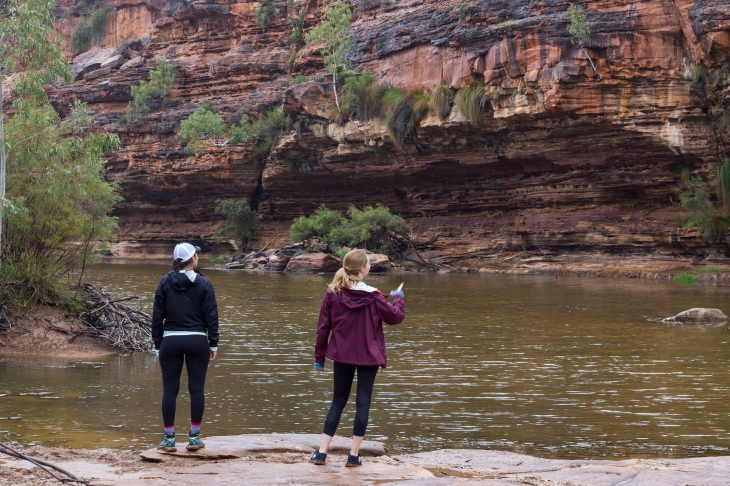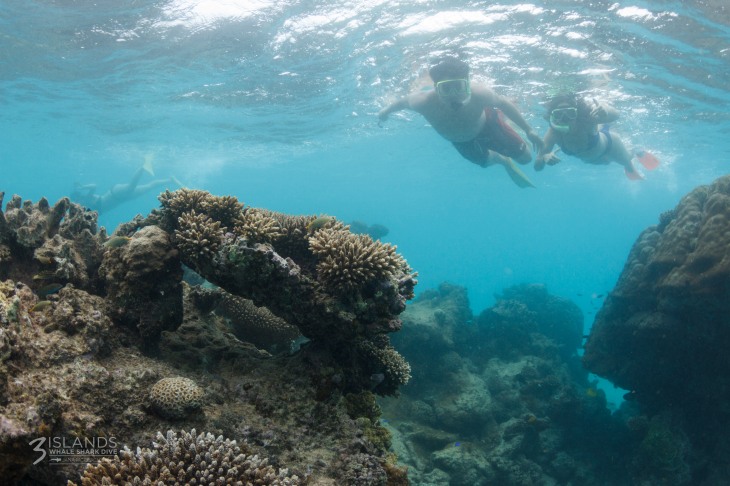When Chris and I first started planning our move to Australia, we planned to check off quite a few items on our bucket list:
- Diving in the Great Barrier Reef ✓ (check!)
- Seeing the sunrise/sunset at Uluru ✓ (check!/check!)
- Climbing the Sydney Harbour Bridge ✓ (check!)
- Learning to surf on the Sunshine Coast ✓ (check…but still a work in progress!)
But one of the activities that we really wanted to check off our list was swimming with whale sharks at the Ningaloo Reef!
So in June, at the beginning of whale shark season in Western Australia (or WA), we headed to Perth to begin our journey to see the biggest fish in the world! And this time, Chris and I would have company. Mel (Chris’ sister) and Lisa (a friend from McGill) would be joining us on our road trippin’ adventure. Check out the awesome video!
We flew across the country to Perth, where we caught up with our friends Kerry and Jean-Gab and met their adorable boys: Louka and Remi. They welcomed us with a BBQ feast… and yes, we finally had some shrimp on the barbie!
Perth is the capital of WA and is a large hub for big name mining companies. The skyline is lit up with logos such as Rio Tinto, BHP Billiton and South32.

Perth skyline
But perhaps Perth’s largest claim to fame is how far it is from, well, everything. If you thought Australia was far from everything, wait until you’ve been to Perth! After all, it is considered to be one of the world’s most isolated cities. The nearest big city with a population of over 1M is Adelaide, which is 2,700 km away or a 28-hr drive!
Although the city may be a little boring (Australians like to hate on Perth), there are a few awesome attractions nearby. One of which is Rottnest Island, home to the cutest animal in the world: the quokka! Mel, Chris and I rented bikes and took a 45-minute ferry to Rottnest, in search of the friendly animal.

Biking on Rottnest Island searching for quokkas! (Photo Credit: MOT)
We were not disappointed. Less than an hour after being on the island, we spotted our first little marsupial, who brazenly approached us on our bikes, curious as to who we were and what we were doing.
Since there are no predators on the island, these miniature creatures are not afraid of anything, and they were definitely not afraid of us! They are extremely curious and will hop up to you to sniff you out. Quokka selfies are a must!
Apart from these adorable little guys, Rottnest Island is quite stunning, with beautiful beaches (great for snorkelling!), rocky cliffs and pods of New Zealand fur seals!

New Zealand fur seals waving hello to us on Rottnest Island (Photo Credit: MOT)

Hanging out on the beach at Rottnest Island (Photo Credit: a big rock)

Rottnest Island (Photo Credit: MOT)
The next morning, we packed our bags and started our 1250-km drive North to Exmouth, the starting point for our whale shark adventure!
Our first stop was Kalbarri, where we were visited the Pink Lake at Hutt’s Lagoon. The Pink Lake is a salt lake containing pink algae, used as a food-colouring agent in cosmetics and supplements.
 We also stopped by the Kalbarri National Park where we hiked a small canyon and scared off a group of swans. FYI – Everything is reversed in Australia: swans are actually black!
We also stopped by the Kalbarri National Park where we hiked a small canyon and scared off a group of swans. FYI – Everything is reversed in Australia: swans are actually black!

Kalbarri (Photo Credit: MOT)

Kalbarri (Photo credit: MOT)
After more than 13 hours of driving, 5 pit stops and a dozen car games, we finally arrived in Exmouth, ready to explore the Ningaloo Reef!

Ningaloo Coast World Heritage Site (Photo credit: MOT)

Photo Credit: Another big rock
The Ningaloo Reef stretches over 260 km along the Ningaloo Coast, which was declared as a World Heritage site in 2011. It is Australia’s second largest reef, after… you guessed it, the Great Barrier Reef!
The great thing about the “Ning” is that you don’t need to jump into boat to explore it. You can simply grab your snorkel gear and head to the beach! Which is exactly what we did. We started by snorkelling in Turquoise Bay at the Cape Range National Park, a beautiful turquoise-coloured beach (duh!).

Turquoise Bay (Photo credit: MOT)
It was a cool and windy 20C when we decided to snorkel (it is winter in Australia after all), but the water was a warm 25c. However, getting out of the water was quite painful.

Snorkelling in Turquoise Bay
We would later return to Turquoise Bay to do a “jumping” photo shoot for the blog!



The next day was our big day with the whale sharks! We got picked up in the morning and started our day with a snorkel in the lagoon where we spotted some awesome marine life: a shovelnose ray, a stingray, an eagle ray, some dolphins, a few reef sharks, a leopard shark, and even a hammerhead shark (which we luckily spotted from the boat)!

Snorkelling in the lagoon at the Ningaloo Reef

Chris chilling with a white tip reef shark

Leopard shark

Shovelnove ray

Stingray

Hammerhead shark!
In the early afternoon, a spotter plane was sent out to try to spot the whale sharks. It took some time but just before noon, our boat got the call that a whale shark had been spotted not far from where we were! We all eagerly zipped our wetsuits back on and waited…
When our guide gave us the signal, we jumped in the water and waited for the majestic creature to swim toward us. Slowly, in the distance, we could all see a dark shape getting larger and larger: it was approaching! An 8-m long whale shark slowly swam next to us with it’s mouth wide open.

Stunned and amazed, we all thought: “Oooooh! Aaaaaaah! So big! So spotty!” (as our tour guides said we would) until we quickly realized that we better start swimming to keep up!

Might as well take a selfie with one. It definitely was not as easy as taking one with a cute little quokka!

Whale shark selfie!
Whale sharks are the largest fish in the world measuring up to 14 meters long, and can weigh up to 30 tonnes (that’s about 10 elephants)! They are considered sharks (not whales) – you can tell because (a) they have gills, and no blow hole (they don’t need to come up for air); and (b) their tail flaps side to side, and not up and down. They are merely called whales because of their immense size.

Whale sharks are filter-feeders and eat tiny ocean organisms and plankton. They are extremely docile and harmless to humans, just be sure to stay clear of their humongous tails! Researchers and marine biologist know very little about these gentle giants, what they do know is that they spend most of their lives at incredible depths and only come up to the surface to warm up. This gives us the opportunity to swim with them! But mating, pregnancy, lifespan, and social behaviours, etc. still remain a mystery.

High on adrenaline, we wanted more! The next day, we woke up at 6am and drove 1.5 hours south to Coral Bay, to swim with manta rays!
Similar to the whale shark experience, our boat had a dedicated spotter plane to search for manta rays! It took a few hours, but we finally spotted one of the more popular female manta rays in the area, and she had a brought a male friend along as well! We jumped in the water and waited for the manta rays to swim by (actually, manta rays look more like they are flying underwater). It was like swimming on top of an underwater magic carpet. These creatures were so elegant and laid back, grazing the bottom of the ocean and communicating with one another when they needed to change direction. The larger manta ray had a wingspan of over 4m! So cool!

Manta rays in Coral Bay
After our manta ray experience, we continued moving south and stopped at Monkey Mia in Shark Bay, where wild dolphins swim to shore almost every morning for a feeding. Obviously this Australian Pelican didn’t want to miss out!

Australian Pelican and dolphins in Monkey Mia
Before heading back to Perth, we stopped in Cervantes to see the Pinnacles, a series of limestone formations, which came from seashells in an earlier era that was rich in marine life. How the Pinnacles were formed is still a subject of debate.

The Pinnacles in Cervantes
We had one last stop in Lancelin for Mel and Lisa to try sand boarding!



We then made our way back to Perth to catch our flight back to Melbourne.
Our trip to Western Australia was an amazing, once in a lifetime experience! We checked off another major item on our bucket list: swimming with whale sharks and, as a bonus, swam with manta rays too!

A special thanks to 3 Islands Whale Shark Dive for taking all the amazing photos during our Whale Shark Experience!






